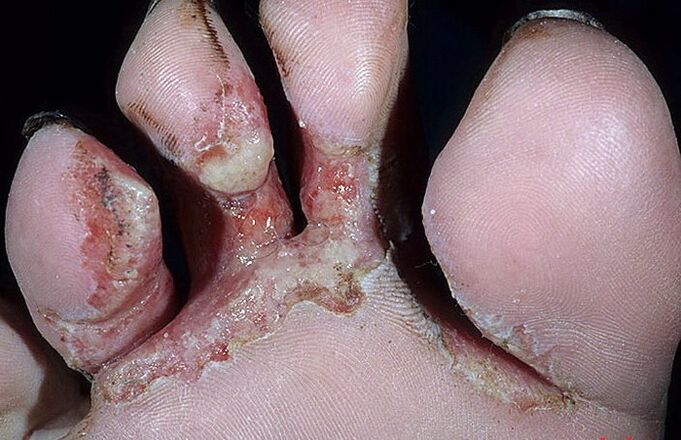Fungus on the feet is considered a common disease. Everyone is prone to mycosis. Infection occurs by touching an infected area of skin or damaged nail particles. A doctor should treat the fungus on the feet. He will choose an effective drug that will quickly get rid of the disease.

The cause of the fungus
Fungus on the feet, which must be treated by an experienced specialist, can occur for the following reasons:
- Pool water, baths or saunas are breeding grounds for various infections. When visiting such places, you must bring your personal shoes. Do not walk barefoot on the floor.
- A humid environment is ideal for rapid fungal growth and reproduction.
- Dry fungal particles can exist for several years. Once they enter a good environment, they will begin to grow actively.
- The disease is often caused by metabolic disorders or endocrine system problems.
- Often, the disease appears in people whose legs are deformed or blood circulation is disrupted.

Fungal symptoms
The symptoms of the disease are determined according to its type. There are several forms:
- squamous;
- dyshidrotic;
- intermediaries;
- foot onychomycosis;
- candidiasis.
Squamous form
Initially, the disease occurs on one leg. If you do not start treatment on time, then it shifts to the second leg. Symptoms of the disease should be considered:
- appearance of redness on the skin;
- peeling off the cover;
- itching (not always associated with disease).

Often, someone who is sick with a squamous infection does not bother with anything. Therefore, with this form, the doctor only needs to see when the infection has spread to both feet.
Dyshidrotic form
The disease is characterized by the appearance of small bubbles (from 2 to 8 mm in diameter) in the arch of the foot. As a rule, they are formed in places where the feet do not touch the floor while walking. After a while, the small focus merges to become large and open. The result is erosion on the skin.
The process spreads from the arch to the inside of the foot. At the site of the bubble opening, a large concentration of erosion occurs, and then a diaper rash. Often, a person feels itching and pain in the places where bubbles form.
Once the erosion has healed and dried, exfoliation will take place in this place. If you do not start treatment on time, then the dyshidrotic form of the disease will develop into squamous cell carcinoma.
Forms of intertrigue
The disease can occur on its own or against the background of squamous fungal forms. Usually, the process begins with a crack in the skin between the fourth and fifth toes.
Symptoms of the disease should be considered:
- the appearance of white rims due to exfoliation of the epidermis;
- the occurrence of weeping wounds between the fingers;
- burning sensation and pain;
- persistent itching.

This form of fungal infection on the feet has a chronic course. In winter, the disease subsides, and in summer it worsens. Lack of proper treatment contributes to the loss of the protective properties of the skin and the penetration of streptococcal infections into the body. As a result, the pustular inflammatory process develops.
Onychomycosis of the feet
The disease is a platinum lesion of the nail. The disease develops, starting from the free edge of the nail. First, spots and yellow streaks appear on the plate.
With hypertrophic onychomycosis, the nails become thicker and turn yellow. It crumbles and fragments easily. The skin underneath thickens.
In the form of atrophic disease, the nail plate becomes thinner and collapses gradually. A layer of keratin skin forms beneath it.
Candidal lesions
In this form, the wound is often located between the third and fourth toes, as well as between the fourth and fifth toes. The symptoms of the disease are as follows:
- edematous and reddish skin;
- abscesses or blisters appear near the focus;
- an exfoliated top layer of skin forms around the redness.

You must see a doctor as soon as you see the first signs. They can be itchy, burning, sore, or peeling skin. After the examination, the specialist will diagnose and prescribe treatment. If you ignore the symptoms, then the infection will affect the entire foot, including the nail plate. In this case, it is difficult to cure the fungus on the feet. Therefore, it is not advisable to start this disease.
How to treat foot fungus
A doctor can choose an effective course. You need to see a specialist and voice the symptoms that are bothering you. An experienced specialist will quickly determine how to treat foot fungus.
Medications
Many different products are available in pharmacies.
Special medications are antifungal agents that inhibit fungal growth. They are available in the form of tablets and capsules, ointments and gels, suspensions, syrups and solutions. Dosage, dosing regimen and duration of treatment are determined by the attending physician.
Folk medicine
Fungal diseases are chronic and do not endanger human health.
Traditional treatment methods are only effective in the early stages. During this period, the symptoms of the disease are not yet known, it is difficult to recognize the fungus. That is why folk remedies are best used in addition to drug treatment.
The most common method of getting rid of fungus is with a vinegar bath. It has a striking antiseptic effect. Bathing is done like this:
- Wash your feet with warm water and dry with a towel.
- Pour the grape vinegar solution into the basin.
- Lower your legs and hold on the pelvis for 3 to 5 minutes.
- Remove your feet and wear socks dipped in vinegar solution.

Treatment should be done at bedtime. Then the socks must be removed in the morning.
Bath soda and sea salt are also effective for treating feet. They are done like this:
- Dissolve one tablespoon of salt and soda in a sufficient amount of water.
- Lower the foot into the solution.
- After 15 minutes, wash your feet with warm water.
It is better to wash the feet with a decoction of herbs. For this, calendula, medicinal verbena, oak bark are suitable. The broth is made as follows:
- The ingredients are mixed in equal amounts.
- 3 tablespoons of the mixture is poured into a glass of water.
- The container is placed over a small fire.
- Warm up in 20 minutes.
- The solution is filtered and cooled.
- The broth is used for rinsing the feet and for lotions.
You can prepare an ointment for the affected foot area. For this, lard and sifted ashes are taken. The ingredients are mixed thoroughly. The ointment is used to clean the skin of the feet in the morning and evening.

Disease prevention
Any disease is easier to prevent than to cure. Therefore, avoid wearing closed shoes all the time. Excessive foot sweating often leads to the development of fungal diseases.
Keep in mind that fungi easily tolerate low temperatures. Upon entering the normal environment, it becomes active and begins to grow rapidly. Therefore, freezing is not a prophylaxis or method of fighting bacteria.
Boiling can kill fungi. To prevent disease, it is necessary to wash clothes at high temperatures and then iron.
To prevent fungal infections, you only need to use your own items and shoes, sterilize tools for pedicures and manicures thoroughly. By following simple rules, you can protect yourself from incurable diseases.
















